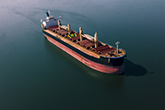How digitalisation can help meet IMO2020 regulations
Published by Stephanie Roker,
Editor
Dry Bulk,
IMO2020 is getting closer and the currently discussed approaches to meet IMO2020 requirements will generate additional pressure to the industry, and thus put many shipping and commodity trading companies in a challenging situation. But how can digitalisation help to meet and manage the IMO2020 regulations?

Digitalisation is a core strategic initiative for many companies, but rarely explored when the topic IMO2020 is discussed. However, digitalisation can help to address IMO2020 impacts in many ways. With IMO2020 bunker procurement processes will become more complex, additional operational costs will be generated, a sophisticated bunker plan will be even more essential and hedging of bunkers will become more competitive, thus impacting the overall voyage P/L – just to mention some of the raising challenges waiting around the corner. Thus, IMO2020 will require companies involved in the shipping and commodity trading industry to rethink the way they’re doing businesses today and at the same time this new regulation might also create new opportunities to outpace competition, if the cards are played wisely. But how can digitalisation help to tackle those challenges in a more efficient way and to grasp the opportunity? Singular Point’s MARiS platform, offers shipping and commodity trading companies a wide range of functionalities to highlight and manage IMO2020 impacts mentioned before.
Using MARiS, shipping companies and commodity trading companies will be enabled to:
- Ensure bunkers are consumed correctly according to IMO2020 regulations in any area of the world and thus avoid any penalties caused by inappropriate usage of bunkers.
- Plan voyages smartly while taking IMO2020 regulations into account during cargo and freight evaluations.
- Be alerted timely, if ECA requirements change in certain ports or areas of the world.
- Include costs for operating scrubbers in their P/L evaluation or any other additional operational cost generated by IMO2020 regulations.
- Improve their bunker procurement process, making sure they can keep straightaway track of bunker prices globally and have the ability to compare different low sulfur bunker and LNG prices that meet the IMO2020 regulations and minimise bunker costs.
- Be able to analyse and compare future bunker requirements against multiple scenarios and thus, simulate different bunker impacts on P/L.
Meeting IMO2020 regulations requires the shipping and commodity trading industry to consider physical and digital approaches as IMO2020 will impact everyone in the industry and beyond. Companies that are able to manage bunker procurement and planning in a more efficient way will be victorious.
Read the article online at: https://www.drybulkmagazine.com/dry-bulk/18062019/how-digitalisation-can-help-meet-imo2020-regulations/
You might also like
Belships announces fleet expansion
Belships has expanded its newbuilding programme with two new 64 000 DWT ultramax bulk carriers which will be delivered in 2028.

